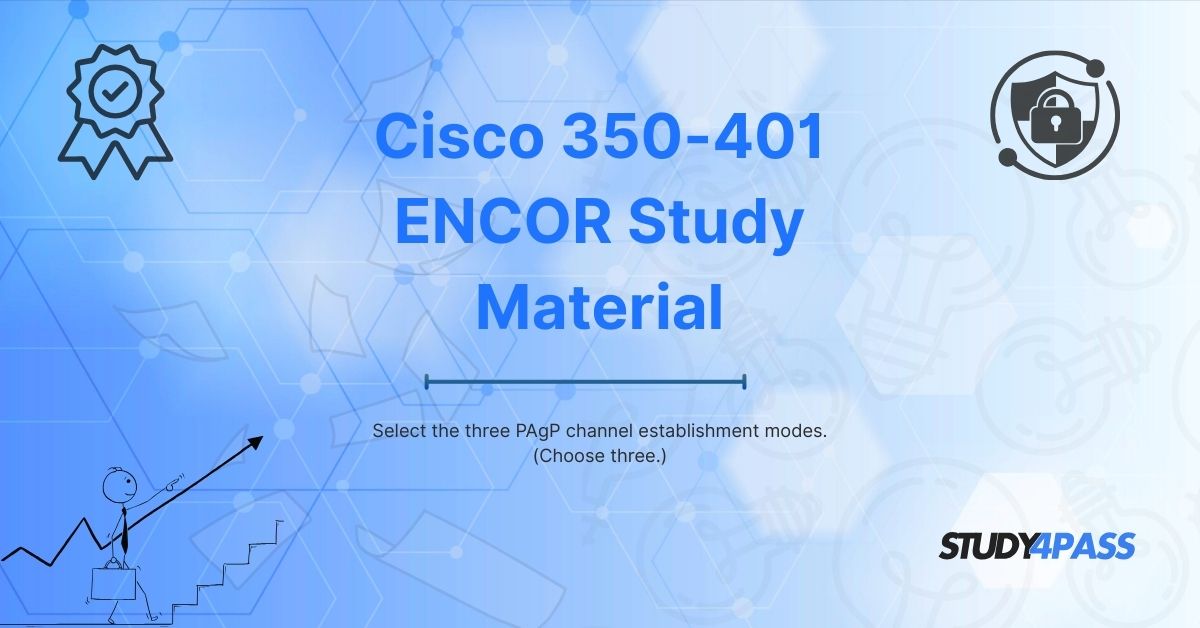Introduction
Port Aggregation Protocol (PAgP) is a Cisco proprietary protocol used to automate the creation of EtherChannel links between switches. It ensures efficient bandwidth utilization and redundancy in network setups. When configuring EtherChannel, selecting the appropriate PAgP mode is crucial for establishing a stable and high-performance network.
This article explores the three primary PAgP channel establishment modes, their functionalities, and their relevance in CCNP Enterprise (350-401 ENCOR) and CCIE Enterprise Wireless exams. Additionally, we recommend Study4Pass as an excellent resource for mastering these concepts through structured study materials and practice exams.
What is PAgP?
PAgP (Port Aggregation Protocol) facilitates the automatic bundling of multiple physical Ethernet links into a single logical link (EtherChannel). It enhances bandwidth, provides redundancy, and simplifies network management.
PAgP operates by exchanging packets between switches to negotiate the formation of an EtherChannel. The three key PAgP modes are:
- Auto
- Desirable
- On (Manual)
Each mode determines how aggressively a switch attempts to form an EtherChannel.
Auto Mode
Definition
- Auto mode is a passive PAgP mode where the switch listens for PAgP packets from the neighboring switch but does not initiate the negotiation.
Behavior
- The switch waits for the other end to send PAgP requests.
- If the neighboring switch is in Desirable mode, an EtherChannel is formed.
- If the neighboring switch is also in Auto, no EtherChannel is established (both are passive).
Use Case
- Useful when you want a switch to form an EtherChannel only if the other switch actively requests it.
- Prevents accidental channel formation in misconfigured networks.
Configuration Example
Switch(config)# interface range GigabitEthernet0/1 - 2
Switch(config-if-range)# channel-protocol pagp
Switch(config-if-range)# channel-group 1 mode auto
Desirable Mode
Definition
- Desirable mode actively attempts to negotiate an EtherChannel by sending PAgP packets to the neighboring switch.
Behavior
- The switch initiates PAgP negotiations.
- Forms an EtherChannel if the other switch is in Auto or Desirable mode.
- Does not form an EtherChannel if the other side is in On (Manual) mode (since PAgP is disabled in manual mode).
Use Case
- Preferred in environments where dynamic EtherChannel formation is needed.
- Ensures faster link aggregation compared to Auto mode.
Configuration Example
Switch(config)# interface range GigabitEthernet0/1 - 2
Switch(config-if-range)# channel-protocol pagp
Switch(config-if-range)# channel-group 1 mode desirable
On Mode (Manual EtherChannel)
Definition
- On mode forces the interface into an EtherChannel without PAgP or LACP negotiation.
Behavior
- No PAgP packets are exchanged.
- EtherChannel is formed only if the other switch is also in On mode.
- Misconfiguration can lead to switching loops (if one side is PAgP and the other is LACP).
Use Case
- Used when connecting to non-Cisco devices that do not support PAgP.
- Requires manual verification to avoid errors.
Configuration Example
Switch(config)# interface range GigabitEthernet0/1 - 2
Switch(config-if-range)# channel-group 1 mode on
Comparison of PAgP Modes
|
Mode |
Sends PAgP Packets? |
Forms EtherChannel With |
Recommended Use |
|
Auto |
No (Passive) |
Desirable |
Passive negotiation |
|
Desirable |
Yes (Active) |
Auto, Desirable |
Active negotiation |
|
On |
No (Forced) |
On (Manual) |
Non-PAgP devices |
Best Practices for PAgP Configuration
- Use Desirable-Desirable or Desirable-Auto for dynamic EtherChannel setups.
- Avoid Auto-Auto as it will not form an EtherChannel.
- Ensure Consistency—both ends must use compatible modes.
- Verify with show etherchannel summary to confirm EtherChannel status.
Why Study4Pass is the Best Resource for CCNP & CCIE Exam Preparation?
Preparing for Cisco certifications like CCNP Enterprise (350-401 ENCOR) and CCIE Enterprise Wireless requires high-quality study materials and hands-on practice. Study4Pass offers:
- Comprehensive Study Guides – Detailed explanations of PAgP, EtherChannel, and other key topics.
- Real Exam Simulations – Practice tests that mimic actual Cisco exam conditions.
- Up-to-Date Content – Aligned with the latest Cisco exam blueprints.
- Expert Support – Access to certified professionals for doubt resolution.
By leveraging Study4Pass, candidates can gain confidence in configuring PAgP modes and other advanced networking concepts, ensuring exam success.
Conclusion
Understanding PAgP channel establishment modes (Auto, Desirable, On) is essential for network engineers pursuing CCNP Enterprise and CCIE certifications. Proper configuration ensures optimal bandwidth utilization and network redundancy.
For structured learning and exam success, Study4Pass provides the best resources, including study guides, practice exams, and expert guidance. Start your journey toward Cisco certification mastery today!
Final Words: Mastering PAgP modes is a stepping stone to advanced network configurations. With Study4Pass, you get the right tools to excel in your CCNP and CCIE exams. Enroll now and take the next step in your networking career!
Note: This article is part of the CCNP Enterprise (350-401 ENCOR) and CCIE Enterprise Wireless study series. For more in-depth tutorials, visit Study4Pass.
Special Discount: Offer Valid For Limited Time “350-401 Study Material”
Actual Exam Questions For Cisco's 350-401 Practice Test
Sample Questions for Cisco 350-401 Exam Prep Practice Tests
1. Which of the following are PAgP (Port Aggregation Protocol) channel establishment modes? (Choose three.)
A) Auto
B) Desirable
C) Passive
D) On
E) Active
2. In PAgP, which mode actively attempts to form an EtherChannel?
A) Passive
B) Auto
C) Desirable
D) Off
3. Which PAgP mode will only form an EtherChannel if the other side is set to "Desirable"?
A) Auto
B) On
C) Passive
D) Active
4. Which of the following is NOT a valid PAgP mode?
A) Desirable
B) Auto
C) Active
D) On
5. If one PAgP interface is set to "Auto" and the other is set to "Desirable," what will happen?
A) An EtherChannel will form.
B) No EtherChannel will form.
C) Only one port will become active.
D) The ports will use LACP instead.


